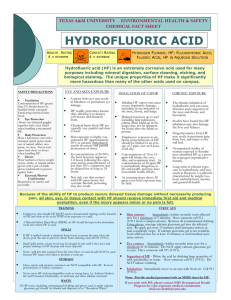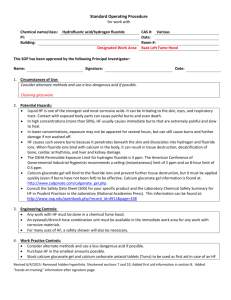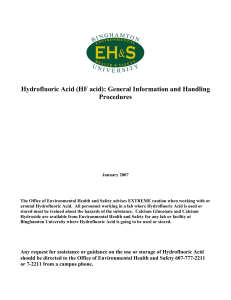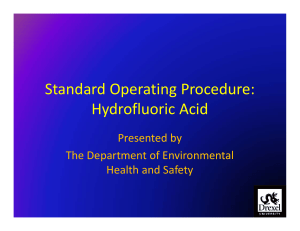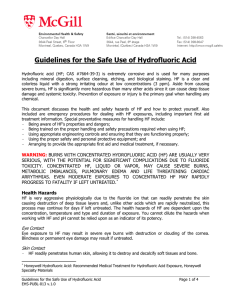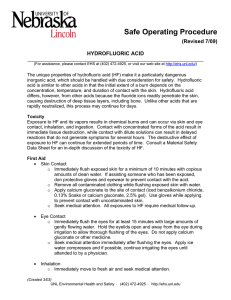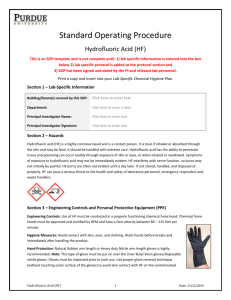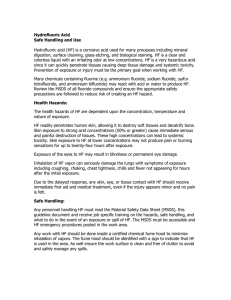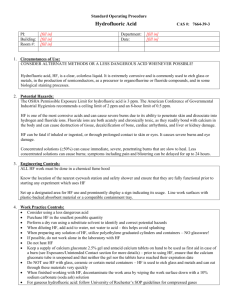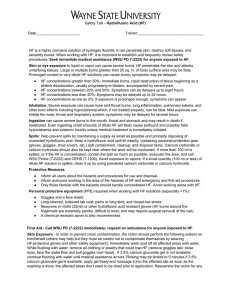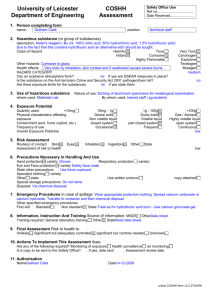Safe Use of Hydrofluoric Acid
advertisement
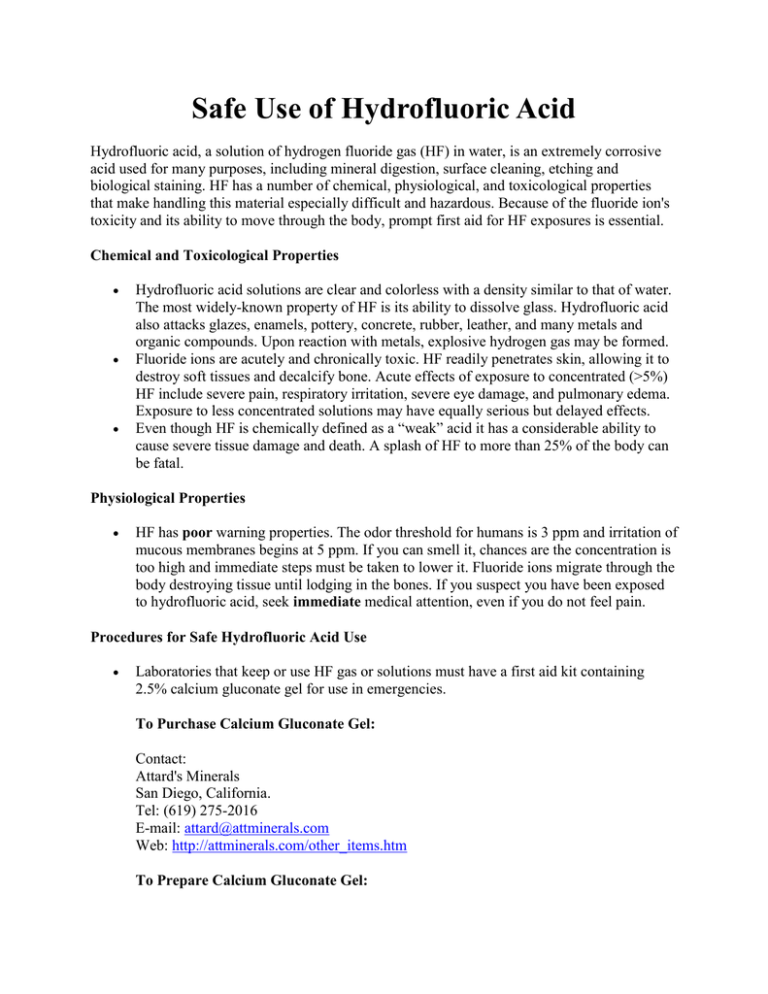
Safe Use of Hydrofluoric Acid Hydrofluoric acid, a solution of hydrogen fluoride gas (HF) in water, is an extremely corrosive acid used for many purposes, including mineral digestion, surface cleaning, etching and biological staining. HF has a number of chemical, physiological, and toxicological properties that make handling this material especially difficult and hazardous. Because of the fluoride ion's toxicity and its ability to move through the body, prompt first aid for HF exposures is essential. Chemical and Toxicological Properties Hydrofluoric acid solutions are clear and colorless with a density similar to that of water. The most widely-known property of HF is its ability to dissolve glass. Hydrofluoric acid also attacks glazes, enamels, pottery, concrete, rubber, leather, and many metals and organic compounds. Upon reaction with metals, explosive hydrogen gas may be formed. Fluoride ions are acutely and chronically toxic. HF readily penetrates skin, allowing it to destroy soft tissues and decalcify bone. Acute effects of exposure to concentrated (>5%) HF include severe pain, respiratory irritation, severe eye damage, and pulmonary edema. Exposure to less concentrated solutions may have equally serious but delayed effects. Even though HF is chemically defined as a “weak” acid it has a considerable ability to cause severe tissue damage and death. A splash of HF to more than 25% of the body can be fatal. Physiological Properties HF has poor warning properties. The odor threshold for humans is 3 ppm and irritation of mucous membranes begins at 5 ppm. If you can smell it, chances are the concentration is too high and immediate steps must be taken to lower it. Fluoride ions migrate through the body destroying tissue until lodging in the bones. If you suspect you have been exposed to hydrofluoric acid, seek immediate medical attention, even if you do not feel pain. Procedures for Safe Hydrofluoric Acid Use Laboratories that keep or use HF gas or solutions must have a first aid kit containing 2.5% calcium gluconate gel for use in emergencies. To Purchase Calcium Gluconate Gel: Contact: Attard's Minerals San Diego, California. Tel: (619) 275-2016 E-mail: attard@attminerals.com Web: http://attminerals.com/other_items.htm To Prepare Calcium Gluconate Gel: Heat a measured amount of K-Y Jelly (Johnson & Johnson) to 50-60°C (typically 395 grams). Add a 2.5% by weight (9.9g) of calcium gluconate, reagent grade, slowly with good stirring until all dissolved. An alternate method of adding the calcium gluconate is to add 2 grams and stir in until mostly dissolved, then add the remaining calcium gluconate (added to 35 cc of H2O) with good stirring until dissolved into the jelly. Finished gel will be water-clear with many air bubbles that can be removed by allowing the bubbles to rise to the surface after standing. Keep a supply of calcium carbonate to absorb spills. Before beginning any procedure involving HF, make sure the nearest safety shower and eyewash is accessible and in proper working condition. When working with HF or concentrated HF solutions (>1%): o o o o Use and store HF in polyethylene or Teflon containers. Glass, metal or ceramic containers are not compatible with HF. Work in a fume hood with the sash closed as much as possible. The fume hood must be compatible with HF, including a non-metallic liner and a polycarbonate sash. Wear goggles and a face shield, a lab coat, pants or a long skirt and closed-toe shoes. Wear butyl rubber gloves. Double gloving is recommended. Leak checking of gloves is advisable. This can be accomplished by blowing the gloves up with air and submerging them in water. Leaking gloves should be discarded immediately. For processes where HF vapor may be produced, ensure that the fume hood does not have a glass sash. All laboratory personnel, not just those who will be using HF, must be informed of the dangers of this chemical and proper first aid procedure to be followed. Training on the hazards of HF and spill response procedures must be documented. If a small quantity (100 ml or less) of dilute HF solution is spilled, clean it up by applying powdered calcium carbonate or calcium hydroxide, or use a commercial HF spill kit. Call EH&S to dispose of the residue. If a larger amount is spilled, or the acid concentrated, contain the spill as best you can, evacuate the area, and call 911. Avoid exposure to the vapors! POST THESE FIRST AID PROCEDURES IN LABORATORY !!!FOR ANY EXPOSURE CALL 911 IMMEDIATELY!!! First Aid . Skin Exposure o Immediately remove all contaminated clothing. o Move the victim immediately under an emergency shower or other water source and flush the affected area for five minutes with large amounts of water. Immediately washing off the acid is crucial o While the victim is being rinsed with water, have someone call to arrange medical treatment. If the exposure is to the eyes or covers a large area (>25% of the body), call 911. For smaller exposures (i.e. a few drops on the skin), call Health Center 330-672-3391. All HF burns should be evaluated by a physician experienced in medical toxicology and treatment of chemical burns. o Immediately after flushing with water, use the following measure: o Start massaging 2.5% calcium gluconate gel into the burn site. Apply the gel every 15 minutes and massage until pain/redness cease or professional medical care is available. Responders must wear gloves when applying the gel to prevent secondary HF burns to their hands. Eye Exposure o Immediately flush eyes for at least 15 minutes with flowing water. o Take the victim to a physician as soon as possible. If possible, apply ice water compresses during transport. Inhalation o Immediately move the victim to fresh air. Call 911 and Employee Health Services at 330-672-3391 in that order. Inhalation of HF fumes may cause swelling in the respiratory tract up to 24 hours after exposure. Persons who have inhaled HF fumes may need prophylactic oxygen treatment and should be seen by a physician as soon as possible. Ingestion o Dilute the acid by drinking large quantities of milk (preferred) or water. o Call 911 o Do not induce vomiting.

